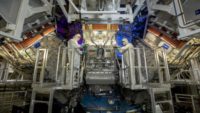
Industry consolidation moved to a new level in 2014, as the push for growth and profit—and increased pressure from new leaders, directors and shareholders—spurred engineering and construction firms to buy and merge globally.
AECOM's $6-billion purchase of URS Corp., creating a 90,000-employee giant, was the year's biggest event in terms of the new megafirm's size and the industry buzz it created. The initial story was the most-viewed item on ENR's website this year, with other related and subsequent stories also among the year's Top 25 in viewership.
Many will watch how the firms' integrate in 2015—under the globally better-known AECOM brand—their managements, clients, technologies and cultures.
Consolidation Express?
Integration also is the watchword now for other firms that forged new global links in 2014's intensified consolidation trend.
They include UK's financially-pressured contractor Balfour Beatty that moved to sell its engineering icon unit Parsons Brinckerhoff despite efforts by Carillion, a rival contractor and potential BB buyer, to block the sale.
In the end, PB was spun off to Canada-based engineer WSP in a monumental $1.35-billion acquisition; updates on this M&A saga landed among ENR's Top 12 in most-viewed stories this year.
And now preparing for a new level of competition as combined companies are: Montreal-based SNC Lavalin and UK construction giant Kentz; UK-based AMEC and America's Foster Wheeler Corp; Australia's GHD and US-based Conestoga-Rovers; US demolition specialists LVI and NCM, and design specialists HOK and 360 Architecture.
AMEC's plan to join forces with Foster Wheeler to boost both firms' fortunes in energy sector work started the 2014 M&A whirlwind in mid-January, while the purchase by Danish engineering giant Ramboll of US-based global environmental specialist Environ wrapped it up in late December.
In between were corporate combinations within and across all geographies, market sectors and revenue and employee totals—as buyers and sellers looked to take best advantage of available cash, cultural fits and favorable valuations.
There was intrigue in the bidding war for UK-based consultant Hyder between Dutch design giant Arcadis and Japan's Nippon Koei that the former finally won, and in big antitrust issues raised by the combination of global materials giants LaFarge and Holcim, and of Vulcan and Martin Marietta.
Whether and how the new entities can propel value for employees and clients will be of keen interest in 2015, as will the trajectory of continuing industry consolidation.
"M&A will have a record year and will increase some 25% over 2014," says Mick Morrissey, a principal of Massachusetts-based management and M&A consultant Morrissey Goodale. "Industry is at a tipping point from a consolidation perspective. High performing firms in hot markets and geographies will command record valuations."
He sees more Chinese and South American design and construction firms "buying into the U.S." through acquisition.
Globetrotting
Executives shared their views on new challenges of doing business internationally at ENR's 2014 Global Summit, held last May in New York. Among other things, they cited multinational workforce management and new competition and compliance issues that will continue to force firms to be selective in picking the right markets, projects and partners to showcase unique skills, please clients and make money.
Latin American cement giant Cemex forged ahead as a global player after the sudden death in May of its CEO Lorenzo Zambrano, while Spanish contractors are refinancing debt and moving aggressively into new international markets to stay competitive; global desalination technology firm IDE Technologies will seek in 2015 to separate from its Israeli industrial owners to boost its market share.
Firms working in Israel and Gaza coped with construction impacts of heightened hostilities this past summer, while others took steps to deal with volatile economic and political changes in China, Russia and in other Middle East-North Africa countries.
E&C companies "will need to take advantage of overseas growth opportunities without putting their companies at risk," says Kent Goetjen, U.S. engineering and construction sector leader at PricewaterhouseCoopers.
Industry executives and observers see some industry market potential in the Obama Administration late-2014 announced plan to normalize relations with Cuba.
"Cuba’s infrastructure is in a sorry state so unless this initiative tubes or is drastically circumscribed, whether by the US Congress or by the Cuban government trying to maintain strict controls, construction materials and [engineering and construction] will be in great demand as time goes by," says Lawrence W. Diamond, a Newark, N.J.-based partner of law firm Duane Morris and chair of its Cuba business group. "While the President’s announcement covers a lot of humanitarian and economic ground, full normalization is likely to be a long-term process. However, the toe is in the water."
Optimism-Hopefully Not Cockeyed
ENR's annual Top List surveys in 2014 of firms in various design, construction, environmental and other market sectors offered some optimism that recovery was taking hold in many sectors and would continue despite continuing market bumps.
Also the ENR quarterly Confidence Index poll of executives reached a record level in the third quarter, with the fewest respondents reporting shrunking markets—and it stayed steady at year-end.
Sliding oil prices are shaping up as a mixed blessing for industry firms. PwC's Goetjen and others speculate on whether it could push out final investment decisions on planned oil and gas projects that have already prompted some publicly held E&C sector specialists to lower their 2015 revenue and earnings projections.
"The drop in oil prices is worrying for firms that have placed a big bet – either through acquisitions or key hires – in the mid-stream pipeline market," adds consultant Morrissey.







Post a comment to this article
Report Abusive Comment